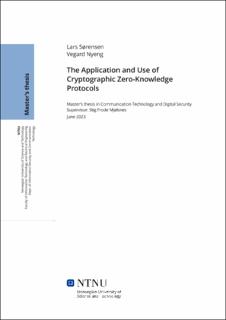| dc.contributor.advisor | Mjølsnes, Stig Frode | |
| dc.contributor.author | Sørensen, Lars | |
| dc.contributor.author | Nyeng, Vegard | |
| dc.date.accessioned | 2023-10-17T17:20:00Z | |
| dc.date.available | 2023-10-17T17:20:00Z | |
| dc.date.issued | 2023 | |
| dc.identifier | no.ntnu:inspera:146715749:34390607 | |
| dc.identifier.uri | https://hdl.handle.net/11250/3097106 | |
| dc.description.abstract | Kryptografiske systemer som benyttes i dag, er hovedsakelig basert på tre matematiske problemer. Rask utvikling innen teknologi gjør at disse systemene står i fare dersom kraftige nok kvantemaskiner blir utviklet.
Slike maskiner har egenskaper som gjør at de kan løse de underliggende problemene som dagens kryptografiske systemer benytter. Kvantesikker kryptografi er et felt innen kryptografi som fokuserer på kryptografiske systemer som kan motstå angrep fra kvantemaskiner. Et lovende felt innen kvantesikker kryptografi er kryptografi basert på gitterstruktur, som bygger på vanskelige problemer innen matematiske strukturer i flere dimensjoner.
Denne oppgaven ser på implementasjonen av og analyserer en digital signatur som benytter kryptografi basert på gitterstruktur. Digitale signaturer spiller en viktig rolle for å sikre dataintegritet, autentisering og ikke-fornektelse i en rekke anvendelser. En slik digital signatur vil bli implementert i et passordløst autentiseringssystem, hvor ytelsen til signaturen vil bli vurdert. Målet med å integrere denne signaturen i en autentiseringsprosess er å forbedre sikkerheten samtidig som en sømløs og enkel brukeropplevelse tilbys. Gjennom en analyse av systemets ytelse vil signaturens effektivitet også bli vurdert.
Resultatene fra denne oppgaven vil bidra til en dypere forståelse av kryptografi basert på gitterstrukturer og dens praktiske implementasjon i autentiseringssystemer. Analysen av systemets ytelse vil gi innsikt i styrker og svakheter ved den implementerte digitale signaturen. | |
| dc.description.abstract | Cryptographic systems today rely mainly on three mathematical hard problems. With the rapid advancement of technology, these cryptosystems face an imminent threat from the development of powerful quantum
computers. With the introduction of a sufficiently powerful quantum computer, many currently deployed cryptosystems may be broken, compromising the security of sensitive information. To address this challenge, post-quantum cryptography has emerged, aiming to develop cryptographic schemes resistant to attacks by classical and quantum computers. One promising branch of post-quantum cryptography is lattice cryptography, which utilizes hard problems within mathematical structures in multiple dimensions to provide strong security guarantees.
This master’s thesis focuses on implementing and analyzing a lattice-based digital signature scheme. Digital signatures play a crucial role in ensuring data integrity, authentication, and non-repudiation in various applications. This research aims to investigate the practicality and performance of a lattice-based digital signature scheme within a passwordless authentication system. Integrating this scheme into the authentication process seeks to enhance security while providing a convenient and user-friendly experience for the end users. The efficiency of the lattice-based digital signature scheme will be reviewed through performance analysis.
The results of this thesis will contribute to the understanding of lattice-based cryptography and its practical application in passwordless authentication systems. Furthermore, the analysis of performance metrics will shed light on the strengths and limitations of the implemented digital signature. | |
| dc.language | eng | |
| dc.publisher | NTNU | |
| dc.title | The Application and Use of Zero-Knowledge Protocols | |
| dc.type | Master thesis | |
